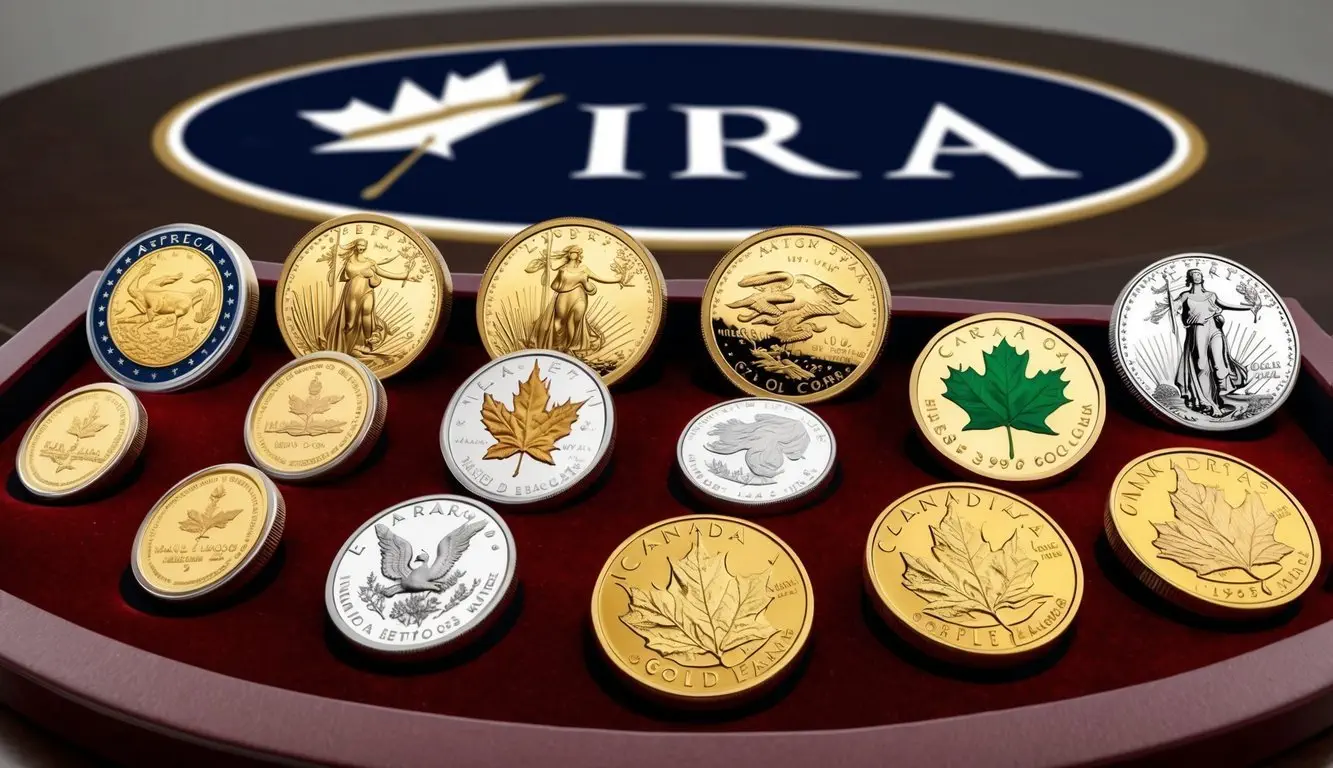Investing in gold has been a timeless strategy for diversifying investment portfolios. IRA Eligible Gold Coins offer a specific way to include this precious metal in your retirement planning.

Not all gold coins qualify for Individual Retirement Account (IRA) investments, as they must meet strict purity standards set by the IRS. These special coins, which include American Gold Eagles and Canadian Gold Maple Leafs, allow investors to gain the potential benefits of gold while enjoying the tax advantages of an IRA.
Adding IRA Eligible Gold Coins to your investment mix can provide a hedge against inflation and market volatility. Many financial advisors suggest allocating 5-10% of retirement portfolios to precious metals as part of a balanced approach to long-term wealth preservation.
Understanding IRAs and Gold Investments

Investing in gold through an Individual Retirement Account (IRA) offers a strategic way to diversify retirement savings. Gold IRAs provide tax advantages while allowing investors to hold physical precious metals as part of their retirement portfolio.
Types of IRAs
Several IRA options exist for investors considering gold investments:
Traditional IRA: Contributions may be tax-deductible, with taxes paid upon withdrawal during retirement. These accounts allow for gold investments through a self-directed IRA structure.
Roth IRA: Funded with after-tax dollars, offering tax-free growth and withdrawals in retirement. Like traditional IRAs, Roth accounts can hold gold through self-directed options.
SEP IRA: Designed for self-employed individuals or small business owners. These accounts have higher contribution limits than standard IRAs.
Self-Directed IRA: The specific structure required for holding physical gold. This account type gives investors control over alternative assets beyond standard stocks and bonds.
Each IRA type has different tax implications and contribution limits. These factors should be considered when planning a gold investment strategy.
Benefits of Gold in an IRA
Gold provides several advantages when included in retirement accounts:
Diversification: Precious metals often move independently of stocks and bonds, helping balance portfolio risk.
Inflation hedge: Gold historically maintains purchasing power during inflationary periods when paper currencies lose value.
Protection against economic uncertainty: During financial crises, gold typically retains or increases in value while other assets decline.
Tax advantages: Gold held in an IRA avoids immediate taxation on capital gains, allowing wealth to grow more efficiently.
Long-term stability: Gold’s enduring value makes it suitable for retirement planning horizons.
Adding gold to a retirement portfolio can provide stability during market volatility. Most financial advisors recommend allocating 5-15% of retirement savings to precious metals.
How Gold IRAs Work
Setting up a gold IRA involves several key steps:
- Choose a custodian: Select an IRS-approved custodian that specializes in precious metals IRAs.
- Fund the account: Transfer funds from existing retirement accounts or make new contributions.
- Select IRA-eligible gold: Purchase gold that meets IRS purity requirements (minimum 99.5% pure).
The gold must be stored in an IRS-approved depository, not personally held. Annual fees typically include storage costs, insurance, and custodian fees ranging from $200-300.
Investors should understand that gold IRAs have specific rules regarding contributions, distributions, and required minimum distributions after age 72. Early withdrawals before age 59½ may incur penalties similar to traditional retirement accounts.
When liquidating gold assets, the metals can be sold for cash or, in some cases, taken as physical distribution subject to applicable taxes.
Eligibility Criteria for Gold in IRAs

The Internal Revenue Service has established specific requirements for gold coins and bullion that can be included in Individual Retirement Accounts. These criteria ensure that IRA investments contain precious metals of sufficient quality and recognized value.
IRS Standards for Precious Metals
The IRS maintains strict guidelines regarding which precious metals can be held in IRAs. Gold must be produced by a national government mint or an accredited/certified refiner/assayer. This regulation helps prevent counterfeit products from entering retirement accounts.
Storage requirements are equally important. IRA-eligible gold must be held by an approved custodian—not the IRA owner personally. The custodian must be a bank, federally insured credit union, savings and loan association, or an entity approved by the IRS to act as trustee.
The IRS also prohibits certain collectible coins with numismatic value from being included in IRAs. The focus remains on gold’s intrinsic metal value rather than its rarity or collector appeal.
Fineness Requirements
Gold fineness refers to the purity of the precious metal. For gold to qualify for an IRA, the IRS requires a minimum purity of .9950 (99.5%) for bars and rounds.
Many investors are surprised to learn that popular 14k and 18k gold jewelry items, despite containing substantial gold, aren’t eligible for IRAs due to insufficient purity levels.
The high fineness requirement ensures the value of the investment comes from the precious metal content itself. This standard helps maintain consistency in valuation and protects investors from lower-quality products.
Testing and certification of gold purity must be performed by approved assayers who verify the gold meets these stringent standards.
Approved Gold Coin Types
Several gold coins meet IRA eligibility requirements and are popular among investors. These include:
- American Gold Eagle coins (allowed despite being 91.67% pure due to special IRS exception)
- American Gold Buffalo coins (24-karat, .9999 fine gold)
- Canadian Gold Maple Leaf coins (.9999 fine gold)
- Australian Gold Kangaroo/Nugget coins (.9999 fine gold)
- Austrian Gold Philharmonic coins (.9999 fine gold)
These government-minted coins provide reliable options for IRA investors. The American Gold Eagle receives special treatment—despite having a fineness of only .9167, it’s explicitly allowed under IRS rules.
Gold bars and rounds are also acceptable if they meet the minimum fineness requirement and come from approved manufacturers. Their weight must be clearly marked, typically ranging from 1 oz to 400 oz.
Popular IRA Eligible Gold Coins

Not all gold coins qualify for IRA investments. The IRS has specific purity requirements, generally 99.5% pure gold for coins to be eligible. These coins must also be produced by government mints or accredited refiners.
American Eagle Gold Coins
American Eagle gold coins remain the most popular choice for IRA investors. Despite containing only 91.67% pure gold (22 karat), they receive a special exemption from the IRS’s 99.5% purity requirement.
These coins are produced by the U.S. Mint and come in four sizes:
- 1 ounce
- 1/2 ounce
- 1/4 ounce
- 1/10 ounce
Only the 1-ounce version is typically recommended for IRA investments due to higher premiums on smaller denominations. American Eagles feature Lady Liberty on the obverse and a family of eagles on the reverse, symbolizing American strength and unity.
The coins are backed by the U.S. government for weight and purity, providing additional security for retirement investors.
Canadian Maple Leaf Gold Coins
Canadian Maple Leaf gold coins, produced by the Royal Canadian Mint, contain 99.99% pure gold, easily meeting IRA requirements. They represent North America’s first 24-karat gold bullion coins.
These coins feature Queen Elizabeth II on the obverse and the iconic maple leaf on the reverse. The Maple Leaf’s exceptional purity has made it a favorite among IRA investors seeking maximum gold content.
Key Features:
- Available in multiple denominations (1 oz, 1/2 oz, 1/4 oz, 1/10 oz, 1/20 oz)
- Contains a full 24-karat gold content
- Includes advanced security features on newer issues
- Legal tender in Canada with face values in Canadian dollars
Many investors appreciate the coin’s simple, recognizable design and exceptional purity standards.
Other Eligible Gold Coins
Several other government-minted gold coins meet IRA eligibility requirements. These options provide diversification beyond American and Canadian offerings.
Australian Kangaroo/Nugget coins contain 99.99% pure gold and feature changing kangaroo designs annually. Their limited mintage sometimes creates higher premiums.
Austrian Philharmonic coins also meet purity standards at 99.99% gold. These coins celebrate the Vienna Philharmonic Orchestra with musical instruments on the reverse side.
American Buffalo coins offer 24-karat (.9999 fine) gold options from the U.S. Mint. They feature an American Indian on the obverse and an American buffalo on the reverse.
When selecting IRA-eligible coins beyond the popular Eagles and Maple Leafs, investors should verify current eligibility with their custodian. Premiums over spot price vary between these options, which can affect long-term investment performance.
Purchasing and Storing IRA Gold

Investing in IRA eligible gold requires understanding the proper procedures for purchasing and storing these precious metals according to IRS regulations.
Choosing a Gold IRA Company
When selecting a gold IRA company, investors should prioritize reputation and experience. Look for companies with strong customer reviews and at least 5-10 years in the industry. The best companies offer transparent pricing with reasonable fees and no hidden costs.
Verify that the company sells only IRS-approved gold coins and bars that meet purity requirements (99.5% pure for gold). This is crucial as non-compliant purchases can result in penalties.
Many reputable gold IRA companies provide education resources to help investors understand their options. They should offer clear guidance on the rollover or transfer process from existing retirement accounts.
Before making a decision, compare at least 3-5 companies and request their complete fee structures in writing.
Custodians and Storage Options
IRS regulations require all IRA gold to be managed by an IRS-approved custodian. These specialized financial institutions handle the paperwork and ensure compliance with tax laws.
The physical gold must be stored in an IRS-approved depository, not in the investor’s home or personal safe. Common depositories include:
- Delaware Depository
- Brink’s Global Services
- International Depository Services (IDS)
Storage options typically include:
| Storage Type | Description | Considerations |
|---|---|---|
| Segregated | Your metals stored separately | Higher fees, fully insured |
| Non-segregated | Your metals stored with others | Lower fees, still fully insured |
Most custodians work with multiple depositories, giving investors geographical diversification options for their physical precious metals.
Understanding Storage Fees
Storage fees are unavoidable when investing in physical gold through an IRA. These fees typically range from 0.5% to 1% of the total value of stored metals annually.
Most depositories charge either a flat annual fee or a sliding scale based on the value of assets stored. For example, an investor with $100,000 in gold might pay $500-1,000 per year in storage fees.
Additional costs to consider include:
- Setup fees ($50-300)
- Annual maintenance fees ($75-300)
- Transaction fees when buying or selling
- Insurance costs (sometimes included, sometimes separate)
Investors should request a comprehensive fee schedule before opening an account. Many custodians offer tiered pricing that becomes more economical as investment values increase.
Be wary of companies advertising “free storage” as these costs are typically hidden elsewhere in higher markup prices on the metals themselves.
Financial Considerations and Tax Benefits

Investing in IRA eligible gold coins offers significant financial advantages, particularly regarding taxation. These benefits can help investors protect their retirement savings while potentially reducing their tax burden.
Tax Advantages of Gold IRAs
Gold IRAs provide several tax benefits similar to traditional retirement accounts. With a Traditional Gold IRA, contributions may be tax-deductible in the year they are made. Taxes are deferred until withdrawal during retirement, when many people fall into lower tax brackets.
Roth Gold IRAs offer different advantages. While contributions are made with after-tax dollars, qualified withdrawals in retirement are completely tax-free. This includes any appreciation in the value of your gold coins.
Unlike regular gold investments, gold held in an IRA isn’t subject to the 28% collectibles capital gains tax rate. This represents significant savings compared to owning physical gold outside an IRA.
IRS regulations require that gold IRAs follow the same contribution limits as other IRAs. For 2025, individuals can contribute up to $7,000 ($8,000 for those 50 and older).
Rollovers and Transfers
Existing retirement accounts can be moved into a Gold IRA without tax penalties if done correctly. There are two primary methods for this transition.
A direct transfer moves funds from one custodian to another without the account holder taking possession. This method avoids withholding taxes and potential penalties. The process is straightforward and can typically be completed with paperwork from the new custodian.
IRA rollovers allow funds to be withdrawn from an existing retirement account and deposited into a Gold IRA within 60 days. This option carries more risk, as missing the 60-day window results in taxes and potential early withdrawal penalties.
The IRS limits indirect rollovers to once per 12-month period across all IRAs. However, direct transfers face no such limitations and can be done multiple times annually.
Investment Strategies and Portfolio Diversification

Adding IRA eligible gold coins to your retirement savings can strengthen your financial security. These precious metals offer unique advantages that complement traditional investments while serving as a safeguard against various economic uncertainties.
Balancing Your Retirement Portfolio
A well-balanced retirement portfolio typically includes a mix of stocks, bonds, cash, and alternative assets. Gold coins can make up 5-15% of your total retirement assets, depending on your risk tolerance and financial goals.
Common Portfolio Allocation Example:
- Stocks: 40-60%
- Bonds: 20-40%
- Cash: 5-10%
- Gold/Precious Metals: 5-15%
This balance helps reduce overall portfolio volatility. When stocks decline, gold often moves independently or in the opposite direction, stabilizing your retirement savings.
For investors approaching retirement, increasing gold allocation slightly may provide additional security. Younger investors might maintain smaller gold positions while focusing on growth-oriented assets.
Mitigating Risks with Gold
Gold serves as a powerful hedge against several economic threats to retirement savings. During periods of high inflation, gold typically maintains purchasing power when paper currencies lose value.
In times of market volatility, gold often demonstrates remarkable stability. For example, during the 2008 financial crisis, the S&P 500 fell over 38% while gold prices rose approximately 5%.
Key Risks Gold Helps Mitigate:
- Currency devaluation
- Stock market crashes
- Geopolitical instability
- Banking system failures
- Inflation spikes
Physical gold cannot default, become insolvent, or go bankrupt. This makes IRA eligible gold coins particularly valuable during financial crises when other assets may face significant challenges.
Building a Long-Term Strategy
Consistent acquisition of gold coins over time often proves more effective than trying to time market fluctuations. Dollar-cost averaging—purchasing fixed dollar amounts at regular intervals—can help accumulate gold at favorable average prices.
Consider diversifying within your gold holdings by acquiring different IRA eligible coins. American Gold Eagles, Canadian Maple Leafs, and Australian Kangaroos offer varying premiums and liquidity characteristics.
Review your gold allocation annually alongside other retirement assets. Rebalancing may be necessary as markets shift and your timeline to retirement changes.
Set clear objectives for your gold investments. Some investors hold gold primarily for wealth preservation, while others seek capital appreciation during economic uncertainty.
Remember that gold’s greatest value comes from its long-term performance and protection benefits rather than short-term gains.
Additional Investment Options in Precious Metals

Precious metals investing extends beyond gold coins. Investors can diversify their retirement portfolios with other metals and investment vehicles that offer different advantages and risk profiles.
Silver, Platinum, and Palladium in IRAs
Silver presents an affordable entry point for precious metals investors. IRA-eligible silver must be 99.9% pure and comes in various forms including American Silver Eagles and Canadian Silver Maple Leafs. Many investors appreciate silver’s industrial applications, which can provide additional demand beyond investment purposes.
Platinum and palladium, while less common in IRAs, offer unique investment characteristics. These metals are crucial for automotive catalytic converters and other industrial applications. IRA-eligible platinum must be 99.95% pure, while palladium requires 99.95% purity.
Investors should note the different price volatility patterns among these metals. Silver typically shows more price movement than gold, while platinum and palladium markets are smaller and can experience significant price swings.
ETFs and Gold Mining Companies
Exchange-Traded Funds (ETFs) offer a convenient way to invest in precious metals without physical storage concerns. Popular options include:
- SPDR Gold Shares (GLD)
- iShares Gold Trust (IAU)
- Aberdeen Standard Physical Silver Shares ETF (SIVR)
Mining companies provide exposure to precious metals with potential growth beyond metal price movements. These companies fall into two main categories:
- Major producers – established companies with multiple operating mines
- Junior miners – smaller companies focused on exploration and development
Mining investments carry different risks than physical metals, including operational challenges, management decisions, and geopolitical factors where mines operate.
Physical vs. Paper Precious Metals
Physical metals offer direct ownership without counterparty risk. Investors hold tangible assets that cannot be defaulted on by financial institutions. These assets can be passed to heirs and maintained outside the financial system.
Paper precious metals (ETFs, mining stocks) provide advantages in liquidity and trading flexibility. They don’t require secure storage solutions or insurance costs associated with physical metals.
The choice between physical and paper investments depends on your investment goals. Physical metals excel as long-term holdings and wealth preservation tools. Paper investments work better for traders seeking exposure to price movements without logistics concerns.
Many experienced investors maintain a mix of both physical and paper precious metals for balanced exposure.
Frequently Asked Questions

Investors considering gold for their retirement accounts need clear information about eligibility requirements, purchasing methods, and tax implications. These questions address the most common concerns when adding precious metals to an IRA.
What are the criteria for a gold coin to be considered IRA eligible?
For a gold coin to qualify for IRA inclusion, it must meet specific IRS requirements. The gold must have a minimum fineness of 99.5% (0.995) purity.
The coin must be produced by a national government mint or an accredited refiner. It cannot be considered a collectible or rare coin.
The coin must be in brilliant uncirculated condition without significant damage that would affect its weight or purity.
Which gold coins are commonly included in the list of IRA eligible options?
American Gold Eagles are the most popular IRA-eligible gold coins. Though they contain 22-karat gold, they have special IRS approval despite not meeting the standard purity requirement.
Canadian Gold Maple Leafs (99.99% pure) and Austrian Gold Philharmonics (99.99% pure) are also common choices for gold IRAs.
Other eligible options include Australian Kangaroos, Chinese Gold Pandas, and American Gold Buffalos, all meeting the required purity standards.
How can one purchase IRA eligible gold coins?
Investors must work with an IRS-approved custodian that specializes in precious metals IRAs. The custodian helps establish a self-directed IRA account.
Once the account is funded, investors select their desired gold coins from an approved dealer. The custodian handles the purchase transaction and arranges secure storage.
Direct purchases are not allowed – all transactions must flow through the custodian to maintain tax-advantaged status.
What are the IRS regulations regarding gold investments in an IRA?
The IRS requires all precious metals in an IRA to be stored in an approved depository. Home storage of IRA gold coins is strictly prohibited.
Annual contribution limits for Gold IRAs are the same as traditional IRAs – $6,500 for individuals under 50 and $7,500 for those 50 and older (2023 limits).
Required Minimum Distributions (RMDs) apply to Gold IRAs just as they do to traditional retirement accounts, beginning at age 73.
How does investing in a Gold IRA compare to holding physical gold?
Gold IRAs offer tax advantages not available with direct physical gold ownership. Potential tax-deferred or tax-free growth depends on the IRA type.
IRA gold requires custodian fees and storage costs, while personal physical gold has no ongoing fees but may require insurance and security measures.
Gold IRAs are specifically designed as long-term retirement investments with penalties for early withdrawal. Personal physical gold can be sold at any time without penalty.
What are the tax implications of including gold in an IRA?
Contributions to traditional Gold IRAs may be tax-deductible, with taxes paid upon withdrawal. Roth Gold IRAs use after-tax dollars with tax-free qualified withdrawals.
Early withdrawals before age 59½ typically incur a 10% penalty plus applicable income taxes. This applies to taking physical possession of the gold coins.
When taking distributions, investors can choose between receiving physical gold or its cash equivalent. Either option has tax consequences based on the IRA type.